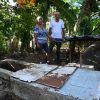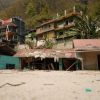Saturday, April 27, 2024
News and Views from the Global South
/ARTS WEEKLY/CULTURE-CUBA: Cienfuegos – Now a World Heritage Site
Dalia Acosta
- The urban historic centre of Cienfuegos, known in Cuba as the "Pearl of the South", has become the first city founded in the 19th century to be inscribed on UNESCO’s World Heritage List of cultural sites.
"Cienfuegos is the only Cuban city that was founded on Spanish colonial territory but initially settled by the French in the 19th century, which makes it incredibly unique," said architect Irán Millán, director of the local Office of Monuments and Historic Sites.
This year, the World Heritage Committee added 17 new sites to its list, which now includes a total of 812 sites (628 cultural, 160 natural and 24 mixed) in 137 member states of the United Nations Educational, Scientific and Cultural Organisation (UNESCO).
The new cultural sites inscribed on the list during the 29th session of the World Heritage Committee, held Jul. 10-17 in Durban, South Africa, also include the Humberstone and Santa Laura saltpetre works in northern Chile, the Russian city of Yaroslavl, and the city of Soltaniyeh in Iran.
Five extensions were also made to previous entries, such as the incorporation of four properties built by architect Antoni Gaudí (1852- 1926)in or near Barcelona, added to three others placed on the list in 1984.
Founded on Apr. 22, 1819 as the township of Fernandina de Jagua and located 250 km southeast of Havana on the Caribbean coast of south- central Cuba, Cienfuegos is "the first and an outstanding example of an architectural ensemble representing the new ideas of modernity, hygiene and order in urban planning as developed in Latin America from the 19th century," according to the World Heritage Committee.
Originally developed in the neoclassical style, Cienfuegos is unique among cities in the Caribbean region for not succumbing to the trend towards eclecticism that took hold in the late 19th century.
As Millán remarked, "the neoclassical code has remained in use. It has been enriched, enhanced and embellished, but based on the same elements that characterised the architecture of the 19th century."
"Sometimes it is impossible to tell if a building dates from the 19th or 20th century, because the formal elements are the same. This is one of the attributes that led to its designation as a World Heritage Site," he added.
With the recent addition of Cienfuegos, there are now eight Cuban cultural or natural sites on UNESCO’s World Heritage List.
In addition to Old Havana and its fortifications, inscribed in 1982, other Cuban cultural sites on the list include the city of Trinidad and nearby Valley de los Ingenios in south-central Cuba (1988) and San Pedro de la Roca Castle in the eastern city of Santiago de Cuba (1997).
The natural sites on the World Heritage List include Desembarco del Granma National Park (1999) and Alejandro de Humboldt National Park (2001), both in eastern Cuba, and Viñales Valley (1999) in western Cuba.
The archaeological ruins of the first coffee plantations in the southeast of Cuba were inscribed as a cultural site on the World Heritage List in 2000, and represent another indelible mark left on the country’s history and landscape by French immigrants.
Several thousand French settlers came to Cuba in the late 18th and early 19th century from the neighbouring island of Haiti, and their most significant contributions include the introduction of coffee growing and the design and colonisation of Cienfuegos.
Among the criteria used to select Cienfuegos for inscription on the World Heritage List, the committee noted that although the city has been and continues to be subject to urban growth, with a 50 percent increase in population over the last 20 years, "the urban fabric has been extended on the same pattern as the first plan."
"The historic core has not been subject to drastic transformations, because it is legally protected," the committee added.
The original urban plan of the city was based on a regular grid with the former Plaza de Armas, now José Martí Park, at its centre.
The core zone nominated for World Heritage status encompasses 70 of the 90 blocks that make up the city’s historic centre, which was hit hard by the passage of Hurricane Dennis in early July.
José Martí Park itself, having just recently undergone a complete restoration, suffered significant damage from the hurricane, which made landfall in Cuba a short distance from Cienfuegos Bay, and caused a total of 16 deaths and an estimated 1.4 billion dollars in damages.
Cuba’s state-run Radio Progreso network announced that the park and the rest of the newly designated World Heritage site, along with the residential neighbourhoods that make up its "buffer zone", will be given special assistance to recover from the damage wrought by Hurricane Dennis.
Millán noted that the damage inflicted was "very pinpointed" and less devastating than the effects of similar storms in recent decades.
"Protection has been a key element in safeguarding the city, and it is backed by both federal laws and provincial and municipal ordinances and regulations, which serve as a guarantee for the preservation of its cultural wealth," he added.

 Print
Print



